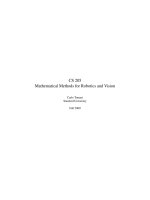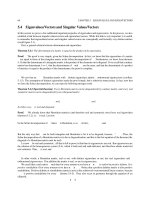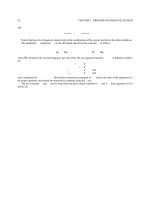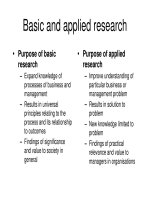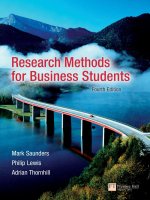Ebook Research methods for business (7/E): Part 1
Bạn đang xem bản rút gọn của tài liệu. Xem và tải ngay bản đầy đủ của tài liệu tại đây (4.4 MB, 190 trang )
www.downloadslide.net
www.downloadslide.net
www.downloadslide.net
An easy way to
help students learn,
collaborate, and grow.
Designed to engage today’s student,
WileyPLUS Learning Space will
transform any course into a vibrant,
collaborative learning community.
Identify which students
are struggling early in the
semester.
Facilitate student
engagement both in and
outside of class.
Measure outcomes
to promote continuous
improvement.
Educators assess the real-time
engagement and performance of
each student to inform teaching
decisions. Students always know
what they need to work on.
Educators can quickly organize
learning activities, manage student
collaboration, and customize
their course.
With visual reports, it’s easy for
both students and educators to
gauge problem areas and act on
what’s most important.
www.wileypluslearningspace.com
www.downloadslide.net
www.downloadslide.net
Research Methods
for Business
Seventh Edition
www.downloadslide.net
www.downloadslide.net
Research Methods
for Business
A Skill-Building Approach
Seventh Edition
Uma Sekaran
and
Roger Bougie
www.downloadslide.net
Copyright © 2016, 2013 John Wiley & Sons Ltd.
All effort has been made to trace and acknowledge ownership of copyright. The publisher would be glad to hear from any
copyright holders whom it has not been possible to contact.
Cover image credit: ©Peshkova. Used under license from Shutterstock.com
Registered office
John Wiley & Sons Ltd, The Atrium, Southern Gate, Chichester, West Sussex, PO19 8SQ, United Kingdom.
For details of our global editorial offices, for customer services and for information about how to apply for permission to
reuse the copyright material in this book please see our website at www.wiley.com.
The rights of Uma Sekaran and Roger Bougie to be identified as the authors of this work have been asserted in accordance
with the UK Copyright, Designs and Patents Act 1988.
All rights reserved. No part of this publication may be reproduced, stored in a retrieval system, or transmitted, in any form
or by any means, electronic, mechanical, photocopying, recording or otherwise, except as permitted by the UK Copyright,
Designs and Patents Act 1988, without the prior permission of the publisher.
Wiley publishes in a variety of print and electronic formats and by print‐on‐demand. Some material included with standard
print versions of this book may not be included in e‐books or in print‐on‐demand. If this book refers to media such as a CD
or DVD that is not included in the version you purchased, you may download this material at .
For more information about Wiley products, visit www.wiley.com.
Designations used by companies to distinguish their products are often claimed as trademarks. All brand names and product
names used in this book are trade names, service marks, trademarks or registered trademarks of their respective owners. The
publisher is not associated with any product or vendor mentioned in this book. This publication is designed to provide accurate
and authoritative information in regard to the subject matter covered. It is sold on the understanding that the publisher is
not engaged in rendering professional services. If professional advice or other expert assistance is required, the services of a
competent professional should be sought.
Library of Congress Cataloging‐in‐Publication Data
Names: Sekaran, Uma, author. | Bougie, Roger, author.
Title: Research methods for business : a skill-building approach / Uma
Sekaran and Roger Bougie.
Description: Seventh edition. | Chichester, West Sussex, United Kingdom :
John Wiley & Sons, [2016] | Includes bibliographical references and index.
Identifiers: LCCN 2015051045 | ISBN 9781119165552 (pbk.)
Subjects: LCSH: Business—Research—Methodology.
Classification: LCC HD30.4 .S435 2016 | DDC 650.072—dc23 LC record available at />ISBN: 9781119165552 (pbk)
ISBN: 9781119266846 (ebk)
A catalogue record for this book is available from the British Library.
Set in 10/12 Minion Pro by SPi Global
Printed and bound in Italy by Printer Trento Srl.
www.downloadslide.net
CONTENTS
About the Authors
Preface
Acknowledgments
1 Introduction to research
Introduction
xix
xxi
xxiii
1
Knowledge about research and managerial effectiveness
Ethics and business research
Summary
Discussion questions
Case: The Laroche Candy Company
1
2
3
3
5
6
7
8
8
9
10
10
10
11
11
11
12
12
13
13
14
15
2 The scientific approach and alternative approaches to investigation
18
Introduction
The hallmarks of scientific research
18
19
19
19
20
20
21
Business research
The role of theory and information in research
Research and the manager
Types of business research: applied and basic
Applied research
Basic or fundamental research
Managers and research
Why managers need to know about research
The manager and the consultant–researcher
Internal versus external consultants/researchers
Internal consultants/researchers
Advantages of internal consultants/researchers
Disadvantages of internal consultants/researchers
External consultants/researchers
Advantages of external consultants/researchers
Disadvantages of external consultants/researchers
Purposiveness
Rigor
Testability
Replicability
Precision and confidence
vii
www.downloadslide.net
viii contents
Summary
Discussion questions
21
22
22
23
23
23
23
23
24
24
24
24
26
27
28
28
28
29
29
29
30
31
3 Defining and refining the problem
33
Introduction
The broad problem area
Preliminary research
33
33
37
37
37
38
39
39
43
43
43
44
45
47
47
48
49
Objectivity
Generalizability
Parsimony
The hypothetico-deductive method
The seven-step process in the hypothetico-deductive method
Identify a broad problem area
Define the problem statement
Develop hypotheses
Determine measures
Data collection
Data analysis
Interpretation of data
Review of the hypothetico-deductive method
Some obstacles to conducting scientific research in the management area
Alternative approaches to research
Positivism
Constructionism
Critical realism
Pragmatism
Conclusion
Nature of information to be gathered
Background information on the organization
Information on the topic or subject area
Defining the problem statement
What makes a good problem statement?
Basic types of questions: exploratory and descriptive
Exploratory research questions
Descriptive research questions
Causal research questions
The research proposal
Managerial implications
Ethical issues in the preliminary stages of investigation
Summary
Discussion questions
www.downloadslide.net
contents
ix
4 The critical literature review
51
Introduction
How to approach the literature review
Ethical issues
Summary
Discussion questions
Practice project
Appendix
Some online resources useful for business research
Bibliographical databases
Apa format for referencing relevant articles
Referencing and quotation in the literature review section
51
54
54
54
54
55
55
55
55
55
55
56
56
57
59
60
61
62
63
63
66
66
69
5 Theoretical framework and hypothesis development
71
Introduction
The need for a theoretical framework
Variables
71
72
72
73
74
75
Data sources
Textbooks
Journals
Theses
Conference proceedings
Unpublished manuscripts
Reports
Newspapers
The Internet
Searching for literature
Evaluating the literature
Documenting the literature review
Dependent variable
Independent variable
Moderating variable
The distinction between an independent variable
and a moderating variable
Mediating variable
How theory is generated
The components of the theoretical framework
Hypothesis development
Definition of a hypothesis
Statement of hypotheses: formats
If–then statements
77
79
81
82
83
84
84
84
www.downloadslide.net
x contents
Managerial implications
Summary
Discussion questions
Practice project
84
85
90
91
92
94
6 Elements of research design
95
Directional and nondirectional hypotheses
Null and alternate hypotheses
Introduction
The research design
Elements of research design
Mixed methods
Trade-offs and compromises
Managerial implications
Summary
Discussion questions
95
95
96
96
97
97
97
98
98
98
99
100
102
104
104
105
106
107
108
108
109
7 Interviews
111
Introduction
Primary data collection methods
Interviews
111
111
113
113
113
115
116
116
117
117
118
119
Research strategies
Experiments
Survey research
Ethnography
Case studies
Grounded theory
Action research
Extent of researcher interference with the study
Study setting: contrived and noncontrived
Unit of analysis: individuals, dyads, groups, organizations, cultures
Time horizon: cross-sectional versus longitudinal studies
Cross-sectional studies
Longitudinal studies
Unstructured and structured interviews
Unstructured interviews
Structured interviews
Review of unstructured and structured interviews
Training interviewers
Some tips to follow when interviewing
Establishing credibility and rapport, and motivating individuals to respond
The questioning technique
Review of tips to follow when interviewing
www.downloadslide.net
contents
xi
Advantages and disadvantages of interviews
Summary
Discussion questions
119
120
120
120
120
121
121
121
121
122
123
123
124
8 Data collection methods: Observation
126
Introduction
Definition and purpose of observation
Four key dimensions that characterize the
type of observation
126
127
Face-to-face and telephone interviews
Face-to-face interviews: advantages and disadvantages
Telephone interviews: advantages and disadvantages
Additional sources of bias in interview data
Computer-assisted interviewing
CATI and CAPI
Software packages
Group interviews
Focus groups
Expert panels
Advantages and disadvantages of observation
Summary
Discussion questions
127
127
128
128
129
130
130
130
131
133
134
136
137
139
140
9 Administering questionnaires
142
Introduction
Types of questionnaires
142
142
143
143
143
145
146
146
Controlled versus uncontrolled observational studies
Participant versus nonparticipant observation
Structured versus unstructured observational studies
Concealed versus unconcealed observation
Two important approaches to observation
Participant observation: introduction
The participatory aspect of participant observation
The observation aspect of participant observation
What to observe
Structured observation: introduction
The use of coding schemes in structured observation
Personally administered questionnaires
Mail questionnaires
Electronic and online questionnaires
Guidelines for questionnaire design
Principles of wording
Content and purpose of the questions
www.downloadslide.net
xii contents
Language and wording of the questionnaire
Type and form of questions
Sequencing of questions
Classification data or personal information
Principles of measurement
General appearance or “getup” of the questionnaire
Review of questionnaire design
Pretesting of structured questions
Electronic questionnaire and survey design
International dimensions of surveys
Special issues in instrumentation for cross-cultural research
Issues in cross-cultural data collection
Review of the advantages and disadvantages of different
data collection methods and when to use each
Multimethods of data collection
Managerial implications
Ethics in data collection
146
146
149
149
150
150
154
155
155
155
156
156
Summary
Discussion questions
157
158
159
159
159
160
160
161
10 Experimental designs
165
Introduction
The lab experiment
165
167
168
168
170
170
170
171
171
172
172
172
173
173
174
174
175
175
176
176
177
Ethics and the researcher
Ethical behavior of respondents
Control
Manipulation
Controlling the contaminating exogenous or “nuisance” variables
Matching groups
Randomization
Internal validity of lab experiments
External validity or generalizability of lab experiments
The field experiment
External and internal validity in experiments
Trade-off between internal and external validity
Factors affecting the validity of experiments
History effects
Maturation effects
Testing effects
Selection bias effects
Mortality effects
Statistical regression effects
Instrumentation effects
Identifying threats to validity
www.downloadslide.net
contents
Review of factors affecting internal and external validity
Types of experimental design and validity
Quasi-experimental designs
Pretest and posttest experimental group design
Posttests only with experimental and control groups
Time series design
True experimental designs
Pretest and posttest experimental and control group design
Solomon four-group design
Double-blind studies
Ex post facto designs
Simulation
Ethical issues in experimental design research
Managerial implications
Summary
Discussion questions
Appendix: Further experimental designs
The completely randomized design
Randomized block design
Latin square design
Factorial design
xiii
178
179
179
179
179
180
181
181
181
183
184
184
185
186
187
189
190
190
191
191
192
11 Measurement of variables: Operational definition
193
Introduction
How variables are measured
Operational definition (operationalization)
193
193
195
Operationalization: dimensions and elements
Operationalizing the (multidimensional) concept of achievement motivation
Dimensions and elements of achievement motivation
What operationalization is not
Review of operationalization
196
197
International dimensions of operationalization
Summary
Discussion questions
198
202
203
204
204
205
12 Measurement: Scaling, reliability and validity
206
Introduction
Four types of scales
206
207
207
208
209
209
Nominal scale
Ordinal scale
Interval scale
Ratio scale
www.downloadslide.net
xiv contents
Ordinal or interval?
Review of scales
Rating scales
Dichotomous scale
Category scale
Semantic differential scale
Numerical scale
Itemized rating scale
Likert scale
Fixed or constant sum scale
Stapel scale
Graphic rating scale
Consensus scale
Other scales
Ranking scales
Paired comparison
Forced choice
Comparative scale
International dimensions of scaling
Goodness of measures
Item analysis
Validity
Content validity
Criterion-related validity
Construct validity
Reliability
Stability of measures
Internal consistency of measures
Reflective versus formative measurement scales
What is a reflective scale?
What is a formative scale and why do the items of a formative scale not necessarily hang together?
Summary
Discussion questions
Appendix: Examples of some measures
Measures from behavioral finance research
Measures from management accounting research
Measures from management research
Measures from marketing research
210
212
213
213
214
214
214
215
215
216
216
217
218
218
218
218
218
219
219
220
220
220
221
221
222
223
224
224
225
225
225
226
227
229
229
230
230
232
13 Sampling
235
Introduction
Population, element, sample, sampling unit, and subject
235
236
236
Population
www.downloadslide.net
contents
Element
Sample
Sampling unit
Subject
Sample data and population values
Parameters
Representativeness of Samples
Normality of Distributions
The sampling process
Defining the population
Determining the sample frame
Determining the sampling design
Determining the sample size
Executing the sampling process
Probability sampling
Unrestricted or simple random sampling
Restricted or complex probability sampling
Systematic sampling
Stratified random sampling
Cluster sampling
Double sampling
Review of probability sampling designs
Nonprobability sampling
Convenience sampling
Purposive sampling
Judgment sampling
Quota sampling
Review of nonprobability sampling designs
Intermezzo: examples of when certain sampling designs would be appropriate
Simple random sampling
Stratified random sampling
Systematic sampling
Cluster sampling
Area sampling
Double sampling
Convenience sampling
Judgment sampling: one type of purposive sampling
Quota sampling: a second type of purposive sampling
Issues of precision and confidence in determining sample size
Precision
Confidence
Sample data, precision, and confidence in estimation
Trade-off between confidence and precision
Sample data and hypothesis testing
xv
237
237
237
237
237
238
238
238
239
240
240
240
241
241
242
242
243
243
244
246
247
247
247
247
248
248
248
249
252
252
252
253
254
254
255
255
255
256
257
257
258
258
259
260
www.downloadslide.net
xvi contents
The sample size
Sampling as related to qualitative studies
Managerial implications
Summary
Discussion questions
261
262
264
264
264
265
265
266
266
268
14 Quantitative data analysis
271
Introduction
Getting the data ready for analysis
Excelsior enterprises: descriptive statistics part 2
Summary
Discussion questions
271
273
273
273
275
276
277
278
279
280
282
282
283
285
285
286
287
289
289
290
292
293
296
297
15 Quantitative data analysis: Hypothesis testing
300
Introduction
Type I errors, type II errors, and statistical power
Choosing the appropriate statistical technique
300
301
302
302
Determining the sample size
Sample size and type II errors
Statistical and practical significance
Rules of thumb
Efficiency In Sampling
Coding and data entry
Coding the responses
Data entry
Editing data
Data transformation
Getting a feel for the data
Frequencies
Bar charts and pie charts
Measures of central tendency and dispersion
Measures of central tendency
Measures of dispersion
Relationships between variables
Relationship between two nominal variables: χ2 test
Correlations
Excelsior enterprises: descriptive statistics part 1
Testing the goodness of measures
Reliability
Excelsior Enterprises: checking the reliability of the multi-item measures
Validity
Testing a hypothesis about a single mean
www.downloadslide.net
contents
xvii
Data warehousing, data mining, and operations research
Some software packages useful for data analysis
Summary
Discussion questions
305
309
311
312
315
315
316
316
319
319
319
320
322
322
322
323
325
326
327
328
329
16 Qualitative data analysis
332
Introduction
Three important steps in qualitative data analysis
Big data
Summary
Discussion questions
332
332
334
347
347
348
350
350
350
350
351
351
352
17 The research report
353
Introduction
The written report
353
354
354
356
Testing hypotheses about two related means
Testing hypotheses about two unrelated means
Testing hypotheses about several means
Regression analysis
Standardized regression coefficients
Regression with dummy variables
Multicollinearity
Testing moderation using regression analysis: interaction effects
Other multivariate tests and analyses
Discriminant analysis
Logistic regression
Conjoint analysis
Two-way ANOVA
MANOVA
Canonical correlation
Excelsior enterprises: hypothesis testing
Overall interpretation and recommendations to the president
Data reduction
Data display
Drawing conclusions
Reliability and validity in qualitative research
Some other methods of gathering and analyzing qualitative data
Content analysis
Narrative analysis
Analytic induction
The purpose of the written report
The audience for the written report
www.downloadslide.net
xviii contents
Characteristics of a well-written report
Contents of the research report
The title and the title page
The executive summary or abstract
Table of contents
List of tables, figures, and other materials
Preface
The authorization letter
The introductory section
The body of the report
The final part of the report
References
Appendix
Oral presentation
Deciding on the content
Visual aids
The presenter
The presentation
Handling questions
Summary
Discussion questions
Appendix: Examples
Report 1: sample of a report involving a descriptive study
Report 2: sample of a report offering alternative solutions and explaining
the pros and cons of each alternative
Report 3: example of an abridged basic research report
A Final Note to Students
Statistical Tables
Glossary
Bibliography
Index
356
357
357
357
358
359
359
360
360
360
361
361
363
363
364
364
365
365
365
366
367
368
368
371
373
377
379
389
399
407
www.downloadslide.net
ABOUT THE AUTHORS
Uma Sekaran was Professor Emerita of Management, Southern Illinois University at Carbondale (SIUC), Illinois.
She obtained her MBA degree from the University of Connecticut at Storrs, and her PhD from UCLA. She was
the Chair of the Department of Management and also the Director of University Women’s Professional
Advancement at SIUC when she retired from the University and moved to California to be closer to her family.
Professor Sekaran authored or co‐authored eight books, 12 book chapters, and more than 55 refereed journal
articles in the management area, and presented more than 70 papers at regional, national, and international
management conferences. She also won recognition for significant research contributions to cross‐cultural
research from US and international professional organizations. She received Meritorious Research Awards both
from the Academy of Management and SIUC, and was conferred the Best Teacher Award by the University.
Roger Bougie is Associate Professor at the TIAS School for Business and Society (Tilburg University, The
Netherlands), where he teaches executive courses in Business Research Methods. He has received a number of
teaching awards, including the Best Course Award for his course on Business Research Methods. Dr Bougie’s
main research interest is in emotions and their impact on consumer behavior, service quality, and satisfaction.
Dr Bougie authored or co‐authored numerous papers, books, book chapters, and cases in the area of Marketing
and Business Research Methods. Dr Bougie is ad hoc reviewer for the Journal of the Academy of Marketing
Science, the Journal of Business Research, the Journal of Marketing Research, and Marketing Letters.
xix
www.downloadslide.net
www.downloadslide.net
PREFACE
I have used previous editions of this book in various research methods courses with great success. For many years
the book has helped thousands of my own students (undergraduate students, graduate students, and executive
students), as well as many more around the world, to carry out their research projects. The great strength of
Research Methods for Business is that students find it clear, informal, easy to use and unintimidating. I have tried
to maintain these strengths in this seventh edition.
CHANGES IN THE SEVENTH EDITION
The seventh edition of Research Methods for Business has been thoroughly revised.
●
●
●
●
Chapter 3 (Defining and Refining the Problem), Chapter 4 (The Critical Literature Review), Chapter 6
(Elements of Research Design), Chapter 7 (Interviews), Chapter 9 (Administering Questionnaires), Chapters 14
and 15 (Quantitative Data Analysis), and Chapter 17 (The Research Report) have been substantially modified
and updated in this edition.
Examples, exercises, and other pedagogical features have been revised and updated in all the chapters.
The structure of the book has not changed, but the storyline has been greatly improved. As in previous editions,
the accessible and informal style of presenting information has been maintained and the focus on practical
skill building preserved.
Chapter 2 introduces and discusses alternative approaches to research. In the new edition, subsequent chapters
follow up on this by reviewing a range of topics (such as research questions, research design, and measurement)
from various perspectives. This allows users of this book to recognize and develop their personal ideas on
research and how it should be done, to determine which kinds of research questions are important to them, and
what methods for collecting and analyzing data will give them the best answers to their research questions.
The book provides numerous examples to illustrate the concepts and points presented. Users will also note
the variety of examples from different areas of the world as well as different areas of business – human resources
management, strategic management, operations management, management control, marketing, finance, accounting,
and information management.
Most chapters in the book include managerial implications of the contents discussed, emphasizing the need
for managers to understand research. The ethical considerations involved in conducting research are also clearly
brought out. The dynamics of cross‐cultural research in terms of instrument development, surveys, and sampling are discussed, which, in the context of today’s global economy, will be useful to students.
We expect that students and instructors alike will enjoy this edition. Students should become effective
researchers, helped by the requisite knowledge and skills acquired by the study of this book. Finally, it is hoped
that students will find research interesting, unintimidating, and of practical use.
HOW TO USE THIS SEVENTH EDITION
You can read this book in a variety of ways, depending on your reasons for using this book.
If the book is part of a Business Research Methods course, the order in which you read the chapters will be
prescribed by your instructor.
xxi
www.downloadslide.net
xxii PREFACE
If you are reading the book because you are engaged in a project (a consultancy project, a research project,
or a dissertation) then the order in which your read the chapters is your own choice. However, we recommend
that you follow the structure of the book rather closely. This means that we advise you to start with reading the
first three chapters that introduce research, various approaches to what makes good research, and the development of a problem statement and a research proposal. Based on the type of research questions and whether, as a
result of your research questions, your study is either qualitative or quantitative in nature you may decide to read
the book in the following way.
In the case of qualitative research:
4
The critical literature review
6
Research design
7, 8, and/or 9
Data collection methods
13
Sampling
16
Qualitative data analysis
17
The research report
In the case of quantitative research:
4
The critical literature review
5
Theoretical framework
6
Research design
9
Questionnaires
10
Experimental designs
11 and 12
Measurement and Scaling
13
Sampling
14 and 15
Quantitative data analysis
17
The research report
COMPANION WEBSITES
Lecturers and students have a dedicated companion website available at www.wiley.com/college/sekaran.
Lecturers will find a range of bespoke video material, developed by the author to provide extra explanation
on difficult topics; videos are signposted in the text. The lecturer website also houses additional case studies
related to each chapter, including accompanying cases for the three new chapters. There is also an extensive test
bank for lecturers, a comprehensive set of PowerPoint slides to accompany the new edition, and an instructor’s
manual, which offers an up‐to‐date and valuable additional teaching aid.
Students will find an online glossary and flashcards, which are useful for self‐study and revision. In addition,
the student website provides self‐test quizzes with over 250 questions for students to use while studying outside
the classroom.
www.downloadslide.net
PREFACE xxiii
ACKNOWLEDGMENTS
Working on the seventh edition of Research Methods for Business has been a positive and rewarding experience.
Many people have contributed to this in many different ways. Thank you colleagues at Tilburg University and
the TIAS School for Business and Society for your feedback on earlier versions of this book. Thank you for
providing me with a pleasant, professional and inspiring work environment. Thank you dear students for the
lively and inspiring discussions we have had during the past twenty years; I have learned a lot from these discussions. Thanks everybody at John Wiley & Sons, in particular Steve Hardman, for your support, your patience,
and your confidence. Thank you reviewers for your constructive and insightful comments on earlier drafts of
this book.
Roger Bougie
